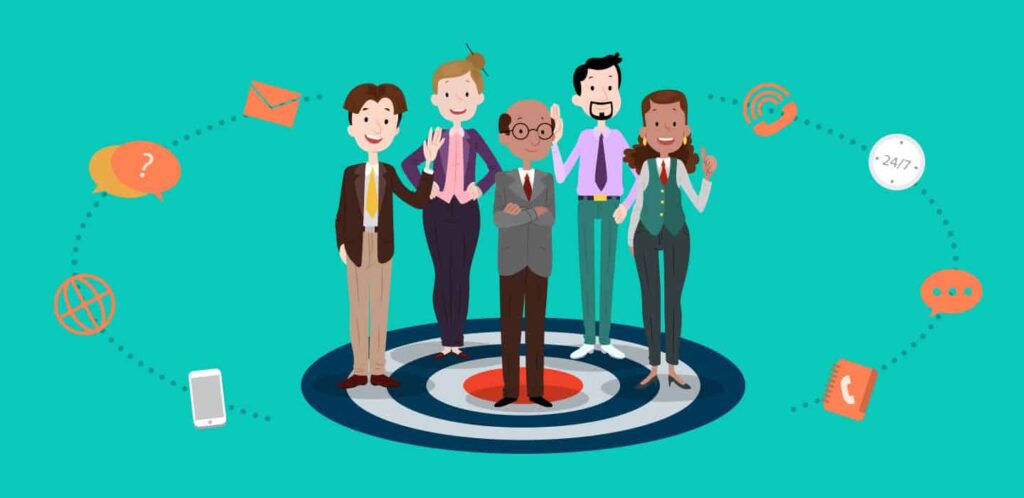About six years ago I experienced a fundamental shift, both in my own work life – in terms of who I worked for – and, more significantly, in how work was done. It was the start of my IT service management (ITSM) journey from the first way of working, into the second. A journey that is now moving into the third way of working.
2010: an ITSM odyssey
At that time, I worked for an “in-sourcing” IT company, which was fully owned by a large advertising, media, and marketing group and provided IT and finance shared services to the group’s operating companies.
This was in circa 2010 and my time at the company, to that point, had been characterized by IT heroics – providing the best service to your customers, and doing whatever it took to keep the agencies producing great ad campaigns. It was fun, but exhausting.
On reflection (and knowing what I know now)
We didn’t have service models or service level agreements (SLAs). Sometimes we logged our work in a Lotus Domino database that was affectionately, but ambitiously, called “The Helpdesk.”
Our channels to service our end users were as casual as they could be. Catch me by email, or if I walk past. Or, if it’s really urgent, I guess I’ll see you in the IT department, all wild eyed and worried, with your blue-screen-of-death laptop in your hands.
At the time we just called this experience “work.” But, retrospectively, I now understand it as “unstructured work” – the first way of work.
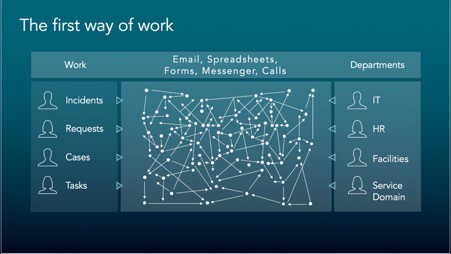
Moving to the second way of work
The fundamental shift (in work) took place around this time. Firstly, we adopted ITSM and transformed the way we worked, and then I had the opportunity to join an ITSM tool vendor to help others on the same journey.
At this point, I recognized that we had hit “peak ITIL.” A new version of the framework was being published (the refresh of ITIL v3 to ITIL 2011), everyone was getting trained and qualified. A million Twitter accounts were spawned to share ideas and prove conclusively, once and for all, who could condense thousands of words of advice into just 140 characters.
We had all fundamentally altered the way we worked and moved from “unstructured work” to “managed work” – the second way of work. And I doubt we’d ever go back.
The second way of work
Recently I was asked by the good people at ITSM.tools to present at the 2018 Service Desk Institute conference.
“Come to Birmingham” they said. “It will be fun” they said. “You can talk about what’s changed since you joined ServiceNow.”
That made me pause for thought. When I first joined, I had hundreds of hours of conversations about change management, and I’m still having those conversations today. Customers were demanding transformed IT, and knowledge, and self-service portal experiences. As they are still today.
Yes – the technology that drives ServiceNow is unrecognizable since 2010. Much as a snake sheds its skin every season, I doubt much of the original code is executed in our datacenters, but fundamentally the customer problems still haven’t gone away.
And I believe it’s because the way we are providing service hasn’t changed.
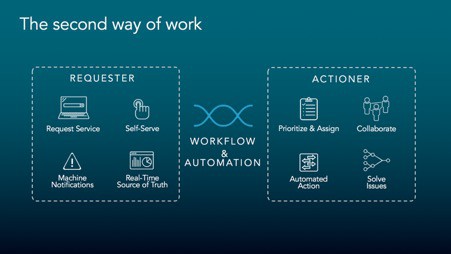
The second way of work, still
In the years since “peak ITIL,” we are still engaged in the second way of work. Formal service models, with task assignment and SLAs. We are doing it better, but we haven’t seen another fundamental shift in our way of working.
I think we’ve tried gallantly. And we’ve tried different ways to improve our working.
Do you remember gamification? The effort that went into this was good. It tried to add a human touch to managed work and make the experience better for the fulfillers of service. I still proudly wear the “gold star” that I won by resolving 100 incidents faster than my colleagues!
However, gamification didn’t provide a shift in how we worked, but instead tried to make managed work more pleasurable for those that engage in it.
Then there was “Social IT.” It tried to take emerging interactions from our consumer technology experience (such as Like, Follow, and Comment) and apply them to managed work. Hopefully to make the work more fluid and easier to engage in.
But Social IT also didn’t provide a shift in how we worked. So, what has fundamentally changed in the last 6 years?
Introducing the third way of work
I would like to propose that we are currently at an apex with managed work. Technologies such as machine learning and artificial intelligence (AI) chatbots provide an opportunity to fundamentally change the way that we engage with ITSM work.
We’re about to move to a third way of work.
Today a huge amount of human effort is spent on repetitive tasks – parsing end user requests to understand the category (what the request is about) and assignment (who should handle the request). This manual effort adds value to the process – because our experience shows that if we aren’t able to apply the correct taxonomy to an incident or to get it to the right resolver the resolution time extends dramatically.
But what does it add to the people engaged in that work?
In organizations that handle tens of thousands of incidents a month, imagine the effort sunk into these manual, repetitive processes. Effort expended by people with limitless empathy, creativity, and potential are spending hours and hours reading end user issues to apply the correct category and assignment.
It’s a criminal waste of human effort.
How the third way of work will help ITSM
The third way of work will put people at the center of the experience and will put technology at the service of that person. Whether you are a requester – seeking solutions or trying to get help with a problem – or a fulfiller that has to deal with a high volume of incoming work, these innovations will make technology work for you.
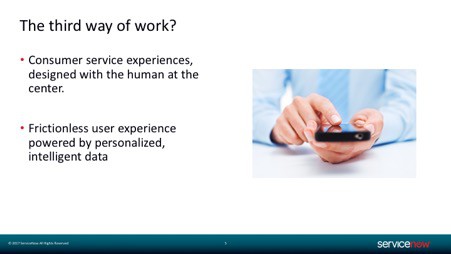
AI chatbots will provide always-on, instant access to answers and will execute tasks on behalf of the consumer. Critically, they’ll be easy to use through natural language commands.
We shouldn’t pretend that the consumer will be fooled into thinking that they’re dealing with a human, this is not the point. This virtual agent will be recognizable as a machine but will be useful for a wide range of tasks that an end user wants to do.
When you speak to your Amazon Echo device – “Alexa, turn on the living room lights” – you aren’t under any pretense that Alexa is a human. She’s a robotic agent willing to do the mundane jobs for you.
Machine learning will free up human service desk operators by making predictive calculations on incoming work, determining the right attributes (category and assignment) that will get the work to the right people first time. It will do this repetitive work faster than a human with a higher rate of accuracy.
In one of the Terminator films a main character says:
“Listen and understand, that Terminator is out there. It can’t be bargained with. It can’t be reasoned with. It doesn’t feel pity or remorse or fear. And it absolutely will not stop, ever, until you are dead.”
Which sounds quite ominous. But I don’t think we need to be quite so dramatic about machine learning.
The machine will read your incoming incidents and apply categories and will never get bored. Or distracted on Facebook. And it absolutely will not stop, ever, until all of your incidents are assigned to the right team.
There’s more to come (from me, AI, and ITSM)
The aim of this series of four blog posts for ITSM.tools is to help you understand the possibility of the third way of work, specifically machine learning and AI chatbots. But, more importantly, as you will already have some awareness of these terms, to be specific about what is and is not possible today. And lastly, how you can prepare to adopt these new technologies today so that your transition – to the expected advancements in the technologies – will be as quick as possible.
I’ve been involved in ITSM and building cloud platforms for a long time now, but I don’t remember ever feeling like I do today. Aware of new technology that is almost ready for mass-consumption that will fundamentally change the way that I work.
My transition from unstructured work (the first way) to managed work (the second way) happened almost without awareness. I knew that I was going on ITIL training – but I didn’t foresee the outcome.
As we prepare for the third way of work I think we understand better what’s around the corner, and it’s exciting. We need a name for it. Let’s call it intelligent work.
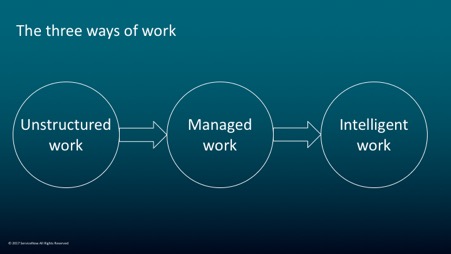
Please return for my next article, where I will dig deeper into the exploitation of machine learning and AI chatbot capabilities.
